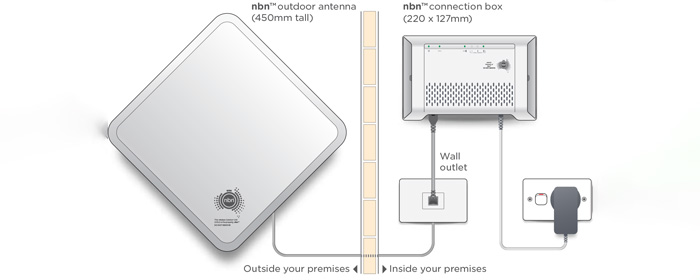One of the technologies being employed in the multi-technology mix rollout of the National Broadband Network, fixed wireless is being used to deliver high-speed broadband access to rural and remote communities of Australia. Alongside satellite NBN, fixed wireless is suitable for homes and businesses that simply can’t be reached by the fixed-line connection types used in more urban areas.
The wireless technology being used by NBN Co – the company responsible for the national network – does, of course, differ markedly from the other technologies in the NBN rollout, with different methods of broadband transmission being employed and different speeds on offer. While a lot of the attention has rightly focused on the fibre rollout, people living in areas covered by fixed wireless need answers to important questions, and help finding the best plan for their needs. That’s our aim in this wireless NBN guide.
On this page:
What is fixed wireless NBN?

Fixed wireless uses a technology known as LTE (also known as 4G), with NBN Co explaining that it works via the transmission of signals “to and from a small antenna fixed on the outside of a home or business, which is pointed directly towards the NBN fixed wireless facility”.
The antenna will be connected by a cable running through the wall to an NBN connection box located within the premises. NBN Co states that each of its fixed wireless facilities serves a set number of premises, with the bandwidth per household designed to be more consistent than mobile wireless.
- The house or building is basically a large 4G network
- Up to 50mbps download, 20mbps upload speeds
- Individual devices then connect as normal to the in-house network
- This results in a more stable connection, as opposed to mobile wireless that can be spotty and inconsistent
- NBN has ruled out the 100Mbps speed tier for fixed wireless services
Despite the dumping of the top speed tier, in April 2017, NBN Co tested fixed wireless speeds in Ballarat and clocked max download speeds of over 1Gbps – 1000Mbps – which is equal to the fastest speeds available to customers on a normal fibre NBN connection. What’s more is that fixed wireless plans are often no dearer than their fixed-line counterparts.
Do I need wireless NBN?
If you live in rural Australia or the outback, you typically need to get fixed wireless NBN for a home internet connection, although sometimes mobile broadband and home wireless broadband can work too. In some areas, satellite internet can be an option, but not in every case.
‘Options’ is a bit of a misnomer as you have no choice about the service you’re able to get. Wireless NBN is basically the alternative NBN connection type that does not use the usual fibre connection or fixed network system rolled out across most of the country, instead employing wireless signals.
Simply put, it’s like a permanent data connection that you’d get with your mobile phone, but for your home, and using radio signals instead of a mobile network. It’s especially useful for homes unable to gain access to the fibre network, or for those in remote areas.
NBN fixed wireless providers
There are a handful of providers offering fixed wireless NBN plans. However, there are significantly less NBN fixed wireless providers than there are provider offering standard NBN plans. The good news is that some offer identical plans as on the fixed network – this means that rural or regional customers don’t lose out. Fixed wireless operates on the NBN’s different speed tiers, and you can expect prices to increase as you jump into a faster plan.
With NBN fixed wireless plans, NBN sheds the top speed tiers as found on fixed-line plans, meaning the maximum speeds generally offered are around NBN 50 (also known as Standard) and as low as NBN 12 (also known as Basic). Some NBN fixed wireless providers, like Activ8me, are exceptions, offering a fast fixed wireless plan with 75Mbps download speed, although these are theoretical maximum speeds.
Here are some providers offering fixed wireless NBN plans:
- Activ8me
- iiNet
- SkyMesh
- Telstra
Best fixed wireless NBN plans
If you’re looking for fixed wireless NBN plans, as previously mentioned, your options for providers and NBN fixed wireless plans will be much smaller than standard NBN plans. The below table shows some fixed wireless NBN plans that are currently available.
Below are some providers from our database with a direct link to their websites. Note that some links may go to the fixed-line plan offerings. Where possible we have included plans from providers that cost the same on fixed wireless as they do on fixed-line.
| Brand | Features | Max Data**/billing period | Advertised Cost^^/billing period | |
|---|---|---|---|---|
 |
min. cost $69.95 over one month |
Unlimited | $69.99 | Go To Site |
 |
min. cost $79.99 over one month |
Unlimited | $79.99 | Go To Site |
| **^^View important information | ||||
What’s good about wireless NBN?
There are three glaring benefits with NBN’s wireless services:
- Ability to reach remote places
- Providing much-needed reliable internet to rural Australia
- Bright future, with gigabit speeds achieved in testing for fixed wireless
Of course, the tradeoff is that fixed wireless NBN can’t reach the same speeds of wired NBN types like HFC and FTTP. NBN 100 (also known as Fast) isn’t an option to fixed wireless NBN customers, and customers might notice more latency issues and lag on fixed wireless connections. This being said, the available speeds are still far better than on ADSL+ or home wireless broadband plans.
How do I connect to fixed wireless NBN?
To get a fixed wireless NBN, you’ll need to get in touch with the internet service provider (ISP) of your choice. Typically you can sign up online through most providers, but often you can sign up over the phone. You’d also need to be living in an area serviceable by fixed wireless NBN. If you live in rural or regional Australia there’s a high chance you can get fixed wireless NBN, but there’s also a chance you have a wired connection at your home, or need to get satellite NBN.
Customers will need to arrange for a technician to visit. An outdoor antenna on the roof of the customer’s home will connect to a designated wall outlet for an indoor NBN connection box to plug into. NBN provider iiNet makes the following recommendations as to where NBN equipment should be installed:
- Within 1.5 metres of an electrical outlet
- In an office or study, or near any existing phone sockets
- A cool, dry and ventilated area with no sinks or water outlets
- Away from busy areas where it may be knocked or damaged
- A place where the equipment can be easily reached
- A place where you’re not planning any major renovations
Customers will also need to check to see if their modem or router is compatible with some ISPs offering modems with their respective plans.
Read more: What to do when your internet is down
What’s the difference between fixed wireless and NBN Fibre?
Fixed wireless uses an outdoor antenna installed at your home, which points in the direction of the nearest fixed wireless transmission tower/base station, to bring internet to remote customers. NBN Fibre, on the other hand, uses fibre optic cable technology to connect to your home, either directly or by utilising existing copper wiring.
Is wireless NBN good value for money?
For a lot of households, fixed wireless NBN is not only good value, but it’s also the best option. Prices are typically higher compared to fixed line NBN plans, but internet speeds will be better than on mobile broadband and home wireless broadband. Just keep in mind a few things:
- Fixed wireless NBN typically charges by the GB, as seen above, whereas fixed line NBN typically offers unlimited data.
- Fixed wireless NBN will be slower than fixed line NBN, but is faster than satellite NBN.
Wireless NBN FAQs
Unlike fixed-line connections, NBN fixed wireless connections do not include top tier speeds with 12Mbps and 25Mbps rather common. The fastest plans generally offer theoretical download speeds of up to 75Mbps and upload speeds of up to 10Mbps.
Of course, the speeds you are actually able to achieve are entirely dependent on the NBN plan you sign up to, your equipment (such as modem), your location in relation to a transmission tower and any obstacles between your home and said NBN transmission tower. Speeds can also be impacted by congestion during peak hours.
If you’re experiencing poor performance or have speed issues with your fixed wireless service, one or more of these factors may be the culprit:
- Quality of networking equipment: if your networking equipment isn’t up to scratch, an upgrade could help to improve your performance.
- Strength of WiFi signal: WiFi modems aren’t all built the same, some have stronger signals, so if you’re noticing spotty coverage then it might be worth checking whether the modem provided matches your desired performance.
- Location of WiFi modem: there are plenty of things that can impact your WiFi signal, such as microwaves, TVs, walls, etc. so making sure you’ve optimised the location of your modem could help improve performance.
- Having multiple devices online simultaneously: the sheer number of users and devices trying to access the internet at the same time may cause your fixed wireless service to slow down. If you do regularly have this issue, it might be worth talking to your provider about options to increase your speed tier.
- Network congestion: during busy periods, there may be congestion on the NBN network, causing your connection to be slow.
For further assistance, it is worth having a chat with your provider to see if there is a solution.
In order to connect to fixed wireless NBN, you’ll need an antenna and NBN connection box, as well as a compatible modem. Most providers will install all of this equipment for you free of charge, however some may charge a fee.




Share this article